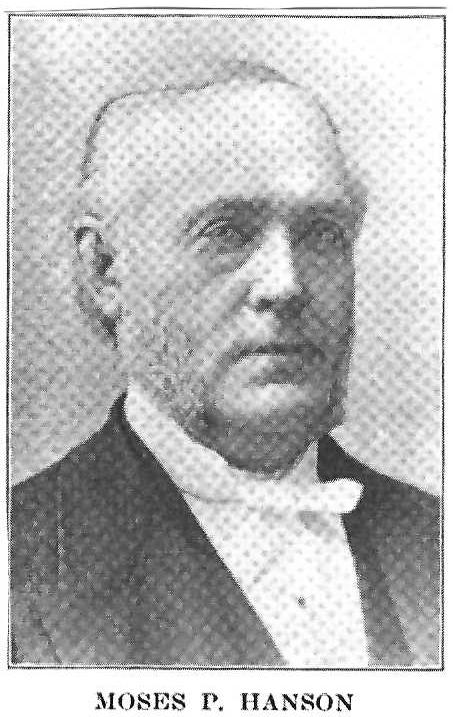“Went to Milwaukee to try Dr. Hanson’s Turkish baths.”
Lavinia Goodell, January 21, 1880
In mid-January of 1880, ten weeks before her death from ovarian cancer, Lavinia Goodell travelled to Milwaukee to seek treatment at a Turkish bath establishment.

The Milwaukee Thermo Therapea was located at 415 Sycamore Street, a few blocks west of the Milwaukee River. (Sycamore Street is now known as Michigan Street.)
The proprietors of the establishment were Dr. Moses P Hanson and George J. Rogers.

Dr. Hanson was born in Maine in 1813 and obtained his medical degree from Bowdoin College in 1838. He came to Milwaukee in 1856. In 1861 he was appointed Assistant Surgeon in the Second Wisconsin Cavalry and was promoted to Surgeon of the Regiment in 1863. He returned to Milwaukee in 1868 and soon thereafter founded the Turkish Bath and Heat Cure, the first such institution west of New York City.
According to an article written in 1912 by L. P. Haskell, a dentist who was Dr. Hanson’s brother-in-law, Dr. Hanson operated the Turkish bath sanitarium for twenty-five years. Dr. Haskell described a Turkish bath as “the application of dry heat to the naked skin with temperature ranging from 150 degrees to 220 degrees Fahrenheit.” The specifics of the treatment were as follows:
The patient, divested of clothing, lies down on a lounge with sheet wrapped around, and remains a half hour or more until thorough perspiration has resulted, drinking all the water he wishes. If he should possibly feel faint, he goes to the cooling room a few minutes and returns to the hot room…. From the hot room one goes to the shampooing room, lies upon a marble slab and the operator gives a thorough massage of the whole body, then scrubs with brush or hair mitten, then to the shower, first hot and gradually colder; some take the plunge. The patient is then wiped and goes to the cooling room, lies upon a lounge wrapped in a sheet until cool and dry, then dresses.
Dr. Hanson was an acquaintance of Lavinia’s father. In an October 1874 letter to her sister, Lavinia mentions visiting the doctor while attending a temperance convention in Milwaukee and described his family as as “old anti-slavery people, who used to know Father. … They keep a large establishment, and give Turkish baths. ” Lavinia visited Dr. Hanson again in October 1879. According to an obituary published in the Chicago Tribune after Dr. Hanson’s death in 1893, he “was an uncompromising abolitionist” who assisted a fugitive slave on his journey over the underground railroad, and he “was a temperance advocate from his earliest days and his highest ambition was to benefit his fellow-men.” Given that Dr. Hanson was an old family friend, it is not surprising that Lavinia would have trusted him enough to try his thermal bath cure. This was not the first time she had tried unconventional treatments. Read about others here.
Dr. Hanson advertised his establishment in various religious journals. An ad in an 1872 Presbyterian and Congregational church publication touted the many benefits of the Turkish bath:

The Wisconsin State Medical Society did not look kindly on Dr. Hanson’s business or his advertisements, and it repeatedly refused to admit him to membership in the Society. The Society’s minutes from 1870 state:
In regard to the application of Dr. Moses P. Hanson of Milwaukee, your Board cannot recommend the said Dr. Hanson for Membership. His occupation and style of procuring business in not in accordance with the Medical ethics of the American Association. He is known throughout this State as the proprietor and operator of a Turkish Bath, or as his sign has it, “Thermo Water Cure.” His advertisements violating the code of ethics have been scattered broad-cast over the State.
According to her sister, Lavinia stayed at Dr. Hanson’s establishment until early March, when it became clear the treatments were not helping. Lavinia was then taken “carefully in a chair to the house of a former neighbor who kindly consented to receive her, furnishing her with a pleasant front room, and such opportunities for care as her case required.” The house was within a block or so of Hanson’s Turkish bath establishment. According to her death record, the address was 132 4th Street. Milwaukee’s addresses were renumbered around 1930. According to this table the modern day address would be between Michigan Street (formerly Sycamore) and Wisconsin Avenue. Lavinia died there on March 31, 1880. She was forty years old.
Sources consulted: Lavinia Goodell’s diary; Letter from Lavinia Goodell to Maria Frost (October 29, 1874); 1880 Milwaukee City Directory; History of Milwaukee, Wisconsin: From Pre-historic Times to the Present Date (Western Historical Company, Chicago, Illinois 1881); Transactions of the Wisconsin State Medical Society for the years 1869 and 1870; “The Turkish Bath,” by L. P. Haskell, D.D.S., published in The Dental Brief: An American Journal of Dental Science, Art and Literature, Vol. XVII (I. D. Caulk, Philadelphia, Pa. 1912); Chicago Tribune (January 21, 1893); Minutes of the Presbyterian and Congregational Convention of Wisconsin (1872); Minutes of the Wisconsin Annual Conference of the Methodist Episcopal Church (1884); Life of Lavinia Goodell (unpublished biography by Maria Goodell Frost).








Great information. 132 4th Street was just a couple houses north of Sycamore (Michigan) on 4th Street. The 1894 Sanborn map shows the house and the building Dr. Hanson used, a hotel by 1894.